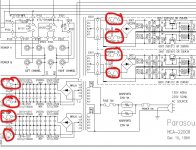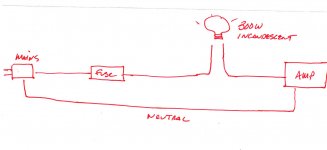Since you have another identical amplifier, measure how much current each is pulling and compare.
How do I check that?Since you have another identical amplifier, measure how much current each is pulling and compare.
I do know that the other amp is dead quiet - I can put my ear up to it and not hear any hum. The other one, however, I can now hear a hum standing 3-4 feet away from it.
Looks like I am going to be putting those old thermistors back in (or run the light bulb bypass) just to see if that is the issue. Unless something got damaged not sure what else could have happened.
An inductive current meter would be easiest on a single wire on the primary side of the transformer. The wire from the fuse to the switch would work very well if it is exposed for the inductive pickup.
AKA, a clamp-on ammeter or clamp meter.An inductive current meter would be easiest on a single wire on the primary side of the transformer. The wire from the fuse to the switch would work very well if it is exposed for the inductive pickup.
Attachments
So today I bypassed the thermistor board using the 300w light bulb as the current limiter and I get no hum from the transformer however I think the light bulb is limiting the current flow and the amp is not getting full power. I think this is so because I do not hear the internal relays in the amp click as they normally do when power is applied.
Can I use a different light bulb or some other method to bypass the thermistor board to supply full current to the amp but still protect the amp from the inrush current?
I now have a variac and it occurred to me that I could eliminate the light bulb and just use the variac to slowly ramp up the power but wanted to see what your thoughts were before doing so.
Thanks.
Can I use a different light bulb or some other method to bypass the thermistor board to supply full current to the amp but still protect the amp from the inrush current?
I now have a variac and it occurred to me that I could eliminate the light bulb and just use the variac to slowly ramp up the power but wanted to see what your thoughts were before doing so.
Thanks.
Attachments
A variac should be fine but I'm tempted to say start with it set to nominal mains output first rather than ramping up from zero. Then you could reduce the supply and see what happens to the hum.
Be aware that variacs on 'full' voltage are usually designed to also increase the voltage. eg a 240 volt variac may well have an output of 0 to 270 volts so set the correct output voltage first.
Be aware that variacs on 'full' voltage are usually designed to also increase the voltage. eg a 240 volt variac may well have an output of 0 to 270 volts so set the correct output voltage first.
Thanks but I am a little slow here trying to understand why I would set it at full voltage - with me bypassing the thermistor board I want to be sure that I don't send to much initial current to the amp at startup and ramping it up (in my feeble mind) is what I need to do.A variac should be fine but I'm tempted to say start with it set to nominal mains output first rather than ramping up from zero. Then you could reduce the supply and see what happens to the hum.
Be aware that variacs on 'full' voltage are usually designed to also increase the voltage. eg a 240 volt variac may well have an output of 0 to 270 volts so set the correct output voltage first.
Some circuits can behave a little unpredictably if the voltage is raised slowly but I see your point 🙂 In practice I think you will find the variac adds enough impedance to limit the surge current anyway.
a 100 watt bulb would allow more current to flow, but still limit to a safe level. I usually start with a 100 watt bulb, then go to a 60 watt bulb, then to a 40 watt bulb, maybe overkill, but each step allows more current to flow.
I usually start with a 100 watt bulb, then go to a 60 watt bulb, then to a 40 watt bulb, maybe overkill, but each step allows more current to flow.
...or vice versa 🙂
Yea, I thought about that when I wrote it, but when you install the the 40 watt, it tends to light up which actually makes the resistance go down. I need to check that at some point. With a 100 watt bulb it briefly lights then goes dim or out which actually raises the resistance.
When I get a chance, I'll plug-in a normally operating amp and check current with each bulb.
When I get a chance, I'll plug-in a normally operating amp and check current with each bulb.
The resistance goes up as the bulb lights 🙂
Measure the resistance of 100 watt filament bulb when cold and calculate the current. The resistance will be really low, around 36 ohms from memory for an old '240v' bulb. As it heats the resistance rises and it draws less current.
So if the amp draws a low current the filament can stay cool and the resistance is low. The amp gets almost full mains. If you fit a lower wattage bulb then that same current might start to heat the lower wattage filament and the bulb lights. The voltage split is now in favour of the bulb and that sees more voltage across it while the amp sees a lower voltage.
Measure the resistance of 100 watt filament bulb when cold and calculate the current. The resistance will be really low, around 36 ohms from memory for an old '240v' bulb. As it heats the resistance rises and it draws less current.
So if the amp draws a low current the filament can stay cool and the resistance is low. The amp gets almost full mains. If you fit a lower wattage bulb then that same current might start to heat the lower wattage filament and the bulb lights. The voltage split is now in favour of the bulb and that sees more voltage across it while the amp sees a lower voltage.
You are 100% right, I'm turned around, LOL. Damn I teach this stuff and still got something so basic turned around. Your explanation should help Wilco also!
to "RickRay From Kansas"
I remember this because I thought I had discovered a convenient dummy-load. But a 14W amplifier made numbers over 50W. Further study suggested the lamp was well over 100R and glowed very dimly in complete darkness.
In 120V land, a 60W incandescent runs near 16 Ohms cold, but obviously 240r (120V 0.5A) hot.around 36 ohms from memory for an old '240v' bulb.
I remember this because I thought I had discovered a convenient dummy-load. But a 14W amplifier made numbers over 50W. Further study suggested the lamp was well over 100R and glowed very dimly in complete darkness.
Interesting, thanks 🙂In 120V land, a 60W incandescent runs near 16 Ohms cold, but obviously 240r (120V 0.5A) hot.
(I'm always surprised that a 500 watt (240 volt again) linear (and a weird name for them) halogen bulb for a floodlight will illuminate dimly on a 12 volt VRLA battery)
So here is what I tried:
1. I connected the 300 watt incandescent bulb as I noted above bypassing the thermistor board. I still got the hum.
2. Then I removed the incandescent bulb and simply ran the fuse but had the variac supplying power. I got the hum around 90 volts up to 110 v.
3. I put the amp side-by-side with my other 2200II (same 20amp dedicated circuit with a power conditioner) and I get absolutely zero hum from the "other" 2200II and this one still hums.
I put a sound meter up inside the amp just to see how loud the hum is and I get 58-64 db when I place it anywhere inside the unit near the transformers.
I hate to put this back in my rack like this because something has apparently happened as a result of the fuses being blown. Note that it powers up fine as before and no more blown fuses but this darn hum is driving me a bit crazy.
Thanks.
1. I connected the 300 watt incandescent bulb as I noted above bypassing the thermistor board. I still got the hum.
2. Then I removed the incandescent bulb and simply ran the fuse but had the variac supplying power. I got the hum around 90 volts up to 110 v.
3. I put the amp side-by-side with my other 2200II (same 20amp dedicated circuit with a power conditioner) and I get absolutely zero hum from the "other" 2200II and this one still hums.
I put a sound meter up inside the amp just to see how loud the hum is and I get 58-64 db when I place it anywhere inside the unit near the transformers.
I hate to put this back in my rack like this because something has apparently happened as a result of the fuses being blown. Note that it powers up fine as before and no more blown fuses but this darn hum is driving me a bit crazy.
Thanks.
I hate to put this back in my rack like this because something has apparently happened as a result of the fuses being blown.
I still think you might be noticing something that may have been present before. If the amp had a problem (whatever that might be... and I don't think it does) then it can only influence the transformer by means of current draw.
Why not pull ALL the rail fuses and power up just the transformer and see what its like. I can see eight fuses.
Remember to discharge all the rails before replacing fuses
You can also use your bulbs on the main DC rails to give a modest load and see if that alters the noise.

Thanks.
I was thinking about unplugging the wires from the transformers to the bridge rectifiers which would essentially remove all load from the transformer.
What do you think?
I was thinking about unplugging the wires from the transformers to the bridge rectifiers which would essentially remove all load from the transformer.
What do you think?
- Home
- Amplifiers
- Solid State
- Help Identifying MOV

